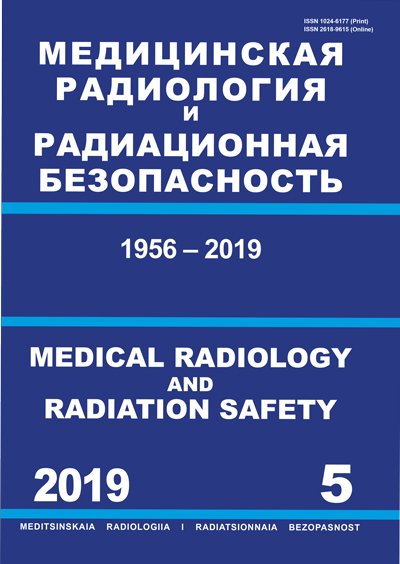Irkutsk State Medical University
CSCSTI 76.03
CSCSTI 76.33
Russian Classification of Professions by Education 14.04.02
Russian Classification of Professions by Education 31.06.2001
Russian Classification of Professions by Education 31.08.08
Russian Classification of Professions by Education 32.08.12
Russian Library and Bibliographic Classification 51
Russian Library and Bibliographic Classification 534
Russian Trade and Bibliographic Classification 5708
Russian Trade and Bibliographic Classification 5712
Russian Trade and Bibliographic Classification 5734
Russian Trade and Bibliographic Classification 6212
Purpose: Assessment the radiation situation in the treatment room of superficial x-ray therapy during the irradiation process in order to inform about radiation exposure of medical personnel or a relatives. Material and methods: In the course of the study, a procedure of superficial radiotherapy was simulated using a tissue equivalent phantom with sizes 250×250×150 mm. The radiation control protocol of measurements on the Roentgen TA-02 apparatus was compiled on the basis of SanPiN 2.6.1.1192-03. With the help of a clinical dosimeter DKS-AT1123, the ambient dose-rate of short-term x-rays was measured. In accordance with the requirements for conducting radiation monitoring, measurements were taken directly near the apparatus in areas 60×60 cm at points located at heights corresponding to the head level (160 ± 20 cm), chest level (120 ± 20 cm), gonad level (80 ± 20 cm) and the level of the legs (30 ± 20 cm). On the basis of the obtained data, the value of the effective dose-rate of x-ray radiation for the whole human body was calculated for each area. Taking into account the characteristics of the irradiation regime used in the clinic, the total effective dose received by the medical personnel accompanying the patient for the entire course of radiotherapy was calculated. Results: A drawn up diagram is illustrating the radiation situation in the treatment room of superficial radiotherapy. Based on the results of calculations, it can be concluded that the radiation exposure on the accompanying person during superficial x-ray therapy of children’s hemangiomas does not exceed the maximum permissible dose specified in paragraph 5.4.4 of SanPiN 2.6.1.2523-09. Conclusion: In exceptional cases, a parent or medical personnel may be in the treatment room to support the patient.
superficial x-ray radiotherapy, radiation control, children, hemangiomas, radiation safety
1. Galchenko LI, Dvornichenko VV, Moskvina NA. Radiation therapy of non-tumorous diseases: a textbook for students. Irkutsk: ISMU. 2015. 28 p. (in Russian).
2. Neroev VV, Berejnova SG, Walskiy WW. Hemangioma treatment efficiency of the combined orbital and periorbital areas in infants. Russian Pediatric Ophthalmology. 2014. 19(2):17-21. (in Russian).
3. Podlyashchuk EL, Butorina AV, Shafranov VV. Radiation therapy with hemangiomas of the orbital region in children. Collection of articles: Advanced technology of medicine at the turn of the century. Moscow: Elikta print. 2000. P. 399-402. (in Russian).
4. Svistunova TM. Low-voltage x-ray therapy with hemangiomas of skin in children. Leningrad: Medicina, Leningrad department. 1974. 127 p. (in Russian).
5. Hygienic requirements for the arrangement and operation of x-ray treatment rooms, devices and conducting x-ray studies (SanPiN 2.6.1.1192-03). Moscow: Ministry of Health of the Russian Federation. 2003. 44 p. (in Russian).
6. Norms of radiation safety (SanPiN 2.6.1.2523-09). Moscow: Energoatomizdat. 2009. 87 p. (in Russian).
7. Ruderman AI. Superficial radiotherapy. Moscow: Medicina. 1968. 234 p. (in Russian).





